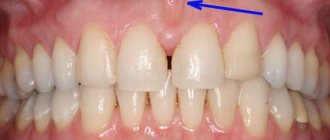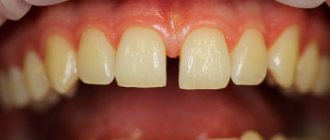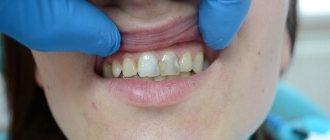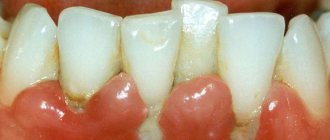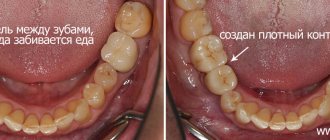According to statistics, every fifth person on the planet suffers from diastema - a gap between the front teeth. This is considered normal, especially if the cleft is small. But both large and small diastemas often become the causes of complexes and even various dental problems. Therefore, it is advisable for everyone who has a gap between their incisors to visit an orthodontist and find out from him how to remove gap between front teeth. Most often, treatment does not take much time, although it does require some investment.
Interestingly, a gap between teeth is considered a sign of creativity and significant talent. Some say that a man with a gap between his incisors is distinguished by a kind and cheerful disposition, and a woman with such a feature of appearance is prone to romantic love. Also, those with a small distance between their teeth are credited with special sensuality and the ability to enjoy the little things.
What is the correct name for the gap between the front teeth?
The correct name for the gap between the front teeth is diastema, which goes back to the Greek word diástema (Greek διαστημα). The term means "distance", "span" or "interval". Although in Greece the word was used without reference to dental disease, today diastema refers specifically to a dental problem.
A more simplified, but also correct name for the gap between the teeth is a gap or chip. This word is used primarily in literary language and works of art. But no matter what you call the problem, it still needs to be treated: although diastema is not the most unpleasant dental pathology, it remains a defect that can cause a number of dental problems.
Teeth straightening with aligners
Re-prosthetics in this situation would be very expensive, since it would be necessary to replace 4 ceramic crowns on the lower front teeth. This method is quick but expensive and does not truly move the roots. By replacing the crowns, we seem to mask the situation. In the end, a different decision was made!
Using the most modern computer developments from the 3DSmile company, we have produced special mouth guards for the lower jaw. Mouth guards for straightening and moving teeth according to a given program. The mouthguards are hard. Each aligner is programmed with minimal tooth movement. Each mouthguard must be worn for 2 weeks. Analysis using special software showed that in order to set the teeth back, remove the gaps between them and return the teeth to the correct position, eight aligners are needed, which must be worn sequentially one after another.
Type of mouthguard on teeth:
The trays on the teeth are almost invisible. They must be worn 23 hours a day. But for meals and in emergency situations, the mouth guard can be removed. This creates additional convenience for the patient.
Alignment with aligners returned the original treatment result!
View of teeth at the beginning of treatment with aligners and after treatment with 3DSmile aligners:
Why does a gap appear between the front teeth?
To understand how to remove the gap between the incisors, you need to understand the causes of this problem. In some cases, diastema is a variant of the norm; it develops if a person grows small teeth with wide upper gums. It is not necessary to fix a small neat gap, as it is more of an aesthetic problem. It is usually hereditary.
This pathology can also occur due to the following reasons:
- too late or early change of teeth;
- congenital absence of one or more teeth (edentia);
- anomaly in the shape or size of the incisors;
- tongue frenulum too low.
Sometimes diastema occurs due to bad habits of chewing pens, pencils and other objects. In adults, a problem arises when the upper molars are lost: the human body is designed in such a way that when a void forms between the teeth, the remaining elements try to fill it, so the molars, incisors and canines diverge slightly and move. This happens very slowly, but eventually sometimes leads to the formation of gaps between the teeth.
Another cause of diastema is severe malocclusion and crooked teeth. Sometimes, if treated incorrectly, the incisors do not fit into place quite correctly, leaving a gap. In this case, it is necessary to continue visiting the orthodontist and complete the adjustment of the dentition.
You can read more about changes in bite and dental anomalies in a separate article on our website: All about bite: what it is like, why it is important to monitor it and how to treat improperly grown teeth.
Duration of retention period
The duration of this period largely depends on the complexity of the pathology that was initially diagnosed in the patient. Long-term wearing of fixation products is necessary when treatment of a deep, distal or open bite took place. In this case, you will need to use the retainer for almost the same period as the person wore braces (up to 2.5 years).
It is important to understand that the duration of the entire therapy is also influenced by the age of the individual patient. In children, correction and rehabilitation occurs much faster than in adults. This is due to the fact that the tissues of the jaw are not yet strong enough and are better susceptible to external influences. Some patients cannot achieve stable results even with constant wearing of a mouthguard, in which case the doctor will advise using a retainer for life.
To be sure of an ideal result, the patient should regularly visit the clinic for examination and make changes to the treatment regimen if necessary. Only a competent approach, careful attitude and following the prescribed recommendations will allow you to maintain the beautiful smile obtained during orthodontic treatment.
previous post
What can you eat after dental implantation?
next entry
Is it possible to get rid of gaps between teeth?
If you have diastema, you should definitely visit an orthodontist, since getting rid of gaps in your teeth is not only possible, but also necessary. Modern treatment methods make it possible to cope with such a problem quite quickly, and dentists offer a large selection of methods for hiding the gap.
The only situation where treatment is not required is diastema on baby teeth in children. This is considered normal and does not require medical intervention. Over time, when the bite changes, the teeth take on the correct position on their own.
A small diastema on baby teeth is normal.
Background - total dental prosthetics
Doctors at the Family Dentistry performed very complex work on dental prosthetics with ceramic crowns, some of which were installed on dental implants (read more about this work here). Total prosthetics was performed - all 28 of the patient’s teeth were restored with ceramics. At the same time, the bite, facial proportions, length and inclination of the teeth were changed. Which, accordingly, required adaptation of the patient’s neuromuscular system to new conditions. The temporomandibular joints, the muscles of the lips and tongue, and the muscles that move the lower jaw and neck had to accept the new teeth and adjust to working with them. Usually such adaptation occurs without problems within a short period of time. But in some cases, muscle tone and a certain activity inherent in the muscles before prosthetics remain after prosthetics and spoil the achieved result.
Compare the situation before and after prosthetics using the most modern Astra Tech dental implants and the most modern E.max restorative ceramics:
The excellent results of prosthetics are obvious. But almost immediately after dental prosthetics, the attending physician Tsukor S.V. I noticed a trend - the lower front teeth have moved slightly apart. At the same time, the position of the remaining teeth remained stable.
Types of diastemas
There are many types of diastemas. They are mainly classified according to the following features:
- False or true. False diastema occurs in children and is considered a type of normal. It disappears on its own after changing the bite. The teeth are not harmed. True diastema is permanent and requires treatment.
- Symmetry. There is a symmetrical cleft, in which the incisors have the same shift relative to each other, and an asymmetrical one, when one of the front teeth occupies the correct position, and the second is shifted. The latter is the most dangerous, because it disrupts the correctness of the dentition.
- Direction of the vertical axis of the incisors. It can be lateral, when the roots are parallel and the crowns diverge, corpus, if the tooth moves along with the root, and medial, when the incisors grow to the side or rotate around their axis.
False and small symmetrical diastemas are practically safe. The first will disappear on its own, the second is just a cosmetic defect. If the position of the tooth root is disturbed or the gap between the incisors is too large, it is better to consider treatment options.
Ways to correct gaps between teeth
The choice of treatment for diastema depends on the reasons for its development, the size of the gap, the characteristics of the patient’s jaw and his budget. The doctor also assesses the patient’s age and the condition of the dentition. All methods can be divided into cosmetic (hiding the problem) and therapeutic (changing the position of the teeth using correction tools). Let's consider the features of each method separately.
Braces
Installing braces is a classic way to eliminate dental deficiencies. They are a non-removable orthodontic structure that is attached to the teeth for a significant period. A variety of braces can eliminate even complex malocclusions, which makes such systems very versatile. During the existence of braces, several varieties of these orthodontic devices have appeared:
- Metal. The most popular and cheapest type of braces. They have a medium size and high efficiency, at a fairly affordable price. Very noticeable on teeth.
- Plastic. They look more aesthetically pleasing than metal ones and do not damage the enamel as much, but when wearing them you should not drink coffee, tea or products that color plastic, as it absorbs the colors.
- Ceramic. The most expensive and beautiful option of braces. They are completely safe, do not change color, and are almost invisible on the teeth.
- Sapphire. They belong to the ceramic group, but require less wearing time than classic models.
There are also gold braces - a premium treatment system, fancy and expensive, and various variations of plastic, metal, ceramics, for example, models with colored ligatures or overlays in the form of hearts, stars and other figures.
Appearance of different types of braces
The maximum effectiveness is shown by wearing braces at the age of 16 to 20 years, when the dentition has already completely changed, but remains quite mobile, because the bone tissue of the jaw is not fully formed. Treatment at this age gives stable and long-lasting results.
The main advantages of braces systems are:
- high efficiency;
- comparative safety;
- the ability to install a hidden bite correction system.
This method of treatment also has disadvantages, namely:
- long wearing period (from one year to 3 years);
- high cost of aesthetic types (sapphire, lingual);
- the need for specialized care, otherwise the risk of developing caries increases;
- Constant wear; braces cannot be removed for an event or during a trip.
Records
The principle of operation of the plate is similar to braces, but it looks different and can be removed from the teeth for a short time. The plates work best at an early age - up to 12 years. At this time, the bone tissue of the jaw is still soft, so the position of the teeth is easy to correct.
Plates for correcting bite
The advantages of records are:
- safety of treatment;
- high efficiency;
- the ability not to wear the product all the time;
Disadvantages of the system:
- may cause discomfort when wearing;
- not suitable for correcting serious defects.
Mouthguards
Mouthguards are orthodontic devices that are placed on the teeth, somewhat reminiscent of covers. They are made specifically for the patient using 3D technology and are sent as a set after taking measurements. The idea is to wear covers that put a little pressure on the teeth at first, then more and more even variations. As a result, the cutters snap into place under plastic pressure.
Transparent aligners are invisible on the teeth
The advantages of mouth guards are:
- ease of maintenance of plastic structures;
- comparative invisibility;
- high efficiency and the ability to simultaneously correct other malocclusions.
Disadvantages of this type of treatment:
- transparent aged aligners are still visible on the teeth and attract attention;
- the patient must strictly adhere to the wearing regime, otherwise the entire set of covers will have to be completely remade (they are made at one time).
Veneers and Lumineers
Veneers are microprostheses that are placed on the outer surface of the tooth. They hide the incisor and allow you to close the gap. Lumineers are made in much the same way as veneers, but they are much thinner and more discreet. Both types of onlays are made from modern materials that closely resemble real teeth, do not change over time and do not cause allergies.
Advantages of veneers and lumineers:
- quick effect, literally in 1-2 doses;
- durability of the onlays (veneers last 10 years, lumineers - about 20);
- impeccable appearance.
Disadvantages of products:
- there are contraindications, for example, veneers and lumineers cannot be placed if a person suffers from bruxism or increased tooth wear;
- cannot be used during an extreme lifestyle (the microprosthesis may fall off).
Veneers, unlike lumineers, have another significant drawback - teeth are ground down to fit them. Lumineers only affect the top layer of enamel, but their price is much higher.
Crowns
When treating diastema in adults, doctors often recommend installing crowns. These permanent structures completely cover the incisor, hiding the gap. At the same time, installing a crown completely restores the functionality of the tooth. True, it has to be sharpened. But, if the incisor has already suffered, for example, it has chipped or been susceptible to caries, this type of treatment is quite justified.
When installing a crown, grinding of the tooth is used
When installing a crown, it is very important to choose the right material. Until recently, there was only one option - metal, most often gold. The cheapest, but also the most visible type of crown. Today it is possible to install products that are very similar to real teeth, for example, ceramic (made of porcelain, aluminum oxide, zirconium dioxide) or metal-plastic. The latter are the cheapest, but can cause irritation to the delicate mucous membranes.
Advantages of crowns:
- safe and effective method;
- you can protect damaged teeth;
- lasts 10-20 years;
- result after several visits to the dentist.
Flaws:
- grinding of the tooth is required, which is unreasonable to do on healthy incisors;
- A crown made of high-quality materials is an expensive solution.
Implants
An implant is an artificial tooth that is mounted on a metal pin secured inside the jawbone. This is the most expensive and highest quality method of restoring teeth if their roots have died and are not preserved. When implants are installed, the functionality of the incisor is completely restored. The pins themselves are made primarily of titanium and are divided by type (each for its own type of tooth: molar, incisor, canine). Crowns can be made from different materials, but metal-ceramics are the most popular, since they stand out the least in the dentition.
Blank for implant installation
The advantages of installing an implant are:
- the effectiveness of the procedure for tooth restoration;
- quick visible results;
- service life is lifelong.
Disadvantages of technology:
- implantation is an operation that requires appropriate preparation;
- it is not always possible to insert a pin into the bone (it may be too thin);
- You will always have a permanent piece of metal with you, this causes certain problems (increased attention from security, inability to undergo an MRI, etc.).
Cosmetic correction
Cosmetic correction is the hiding of the diastema by forming a small filling attached to the sides of the incisors. Essentially, the specialist covers the gap with filling material. This is the simplest and cheapest method that does not harm the teeth.
Advantages:
- harmlessness with high efficiency;
- visible results after the first dose;
- no contraindications.
Flaws:
- if the filling materials were not of sufficient quality, they may change color, disturbing the aesthetics of the dentition;
- on average, a filling lasts 5-7 years, it will have to be changed, it may fall out;
- the incisors will not be able to work fully, the load on them will have to be reduced, otherwise this will lead to damage to the filling.
Artistic restoration
Unlike cosmetic correction, artistic restoration is a more complex procedure that gives a better result. With this method of closing a diastema, the doctor does not simply place a filling, but applies composite materials to the front teeth in layers. As a result, the result looks natural and does not require maintenance or replacement.
Pros of the procedure:
- after one or two visits the result is visible;
- with the help of restoration you can hide quite large distances;
- there are no contraindications;
- Composite materials do not change color over time.
Flaws:
- high price;
- not all diastemas can be corrected in this way;
- you will have to reduce the load on the incisors so as not to damage the composite.
Surgical plastic surgery
Surgery is required if the diastema forms due to abnormal growth of the frenulum. Typically, such an operation is performed in childhood or adolescence, then with the help of orthodontic structures to return the teeth to the correct position. The ideal time for the operation is 5-8 years, since the frenulum will not go away with age. If the child had surgery before the primary bite was changed, the permanent teeth will grow correctly.
Problematic frenulum, its plastic surgery and results
Advantages:
- high efficiency;
- a birth defect is eliminated;
- does not require correction in the future.
Flaws:
- the operation requires appropriate preparation;
- teeth can take several years to fall back into place.
Considering that diastema in children is a normal phenomenon, you need to regularly visit a doctor for examination. It is quite possible that an inexperienced parent will not see the problematic frenulum and will attribute the appearance of gaps to childhood. This is dangerous, because any disturbances in the oral cavity harm not only the teeth, but also the gastrointestinal tract, ability to speak, change the smile, etc.
What to do if a tooth protrudes? About orthodontic movement of individual teeth...
Very often, when we lose our back teeth, we do not immediately run to the dentist to somehow fill the gaps in the dentition. The loss is not noticeable to those around you, you can still chew... well, God bless him! Many people decide this for themselves. What problems this leads to in the future, and how to deal with these problems later, you can see in today’s post.
What happens to your teeth if you have not restored extracted teeth for a long time? They are moving. Moreover, both teeth adjacent to the lost one and those located on the opposite jaw can shift.
This process occurs at different speeds for different people, but the result is always the same - the inability to properly restore a missing tooth, because there is simply no room left for him.
The more time passes after the removal of a tooth and the refusal of its prosthetics, the more the teeth shift. Unfortunately, the resulting dental deformations can lead to new problems. From difficulties with prosthetics to diseases of the temporomandibular joint due to significant malocclusion.
Here, for example, is one of the deformation options.
Due to the long absence of lower teeth, the upper molars have moved downwards. Yes, and so much so that the upper 7 has already rested against the gum of the lower jaw. Now, no matter how much we want, we won’t be able to put a crown on the bottom. There's simply no room for it. What to do in such a situation when the teeth have moved out and do not allow restoration to be made on the opposite jaw?
There are 3 main options:
1. Orthodontic movement of protruded teeth into their place.
2. Filing of protruding teeth.
3. Removal of protruding teeth.
I'll start from the end. Extraction is the last resort when teeth are strongly protruded (approximately as in the photo above) and the patient has no desire to engage in orthodontic movement. Although, if the “gone” tooth is on its way out, then its removal may be the most rational way out of the situation.
Filing teeth is not a very desirable measure. If the protruding tooth is alive, then grinding down the hard tissues can lead to increased sensitivity. If significant grinding is necessary (and this happens quite often), it will be necessary, among other things, to depulp the tooth (remove the nerve from it) and cover it with a crown. Until recently, this was what was done most often. True, in such a situation it will be necessary to file 2 teeth “just” by more than half the length...
Of course, the stumps remaining after such filing will no longer resemble teeth. What to do? Today there is a much more humane way to deal with a tooth that has escaped from its place. Orthodontists help us with this (not to be confused with orthopedists), who professionally know how to move teeth back and forth along the jaw.
How do they do this in cases like the one I presented at the beginning of the article? There can be many ways, depending on the general situation with the bite. But for the sake of simplicity, I will show only one example, which my colleagues, surgeon-implantologist Oleg Yuryevich Ponomarev and orthodontist Daria Sergeevna Kostina, kindly shared with me.
A very common situation was chosen as an example. The patient lost her lower sixth tooth a long time ago. Finally, I decided to restore it a few years later with an implant. It was placed in one of the clinics in our city, but there was not enough space to put a crown on it. This happened due to the upper “six” “sinking” into the empty space. And this is clearly visible in the photo.
The patient refused the attending physician’s offer to file the tooth and went to see my colleagues. As a result, it was jointly decided that this tooth could be reintroduced using mini-implants . How was this done?
First, Dr. Ponomarev installed 2 mini-implants - one on the cheek side, the other on the palate side.
This operation is outrageously simple and not scary. No cuts, no seams. Mini implants have nothing in common with “adult” implants Anesthesia, try it on, whack... whack... and everything is ready. Of course, in skillful hands everything looks simple. There are times when, without really calculating the position of the roots of the tooth, the incompetent doctor screws this very mini-implant straight into the tooth. Such inattention can lead to the removal of an injured tooth. So, as with everything, you need to apply knowledge and skills to make this manipulation truly invisible to the patient.
Well, then the orthodontist comes into play. Dr. Kostina glued special hook buttons to the tooth and tied these hooks to the heads of the mini-implants with rubber bands. This is what it looked like from the cheek side...
and here it is from the sky:
The arrow shows the direction of the force vector that is applied to the tooth by an elastic band. In this case, mini implants act as a support. Now all that remains is to periodically change the weakening rubber bands from the doctor and monitor the movement of the tooth. Depending on the degree of tooth displacement, such treatment can take from 2-3 to 7-8 months.
Some orthodontists do not glue hook buttons to the tooth, but simply throw an elastic band from one miniscrew to another through the tooth. But in this case, the elastic often breaks and can jump off the tooth, cutting into the gum, forcing the patient to re-stretch it, take it off and put it on, etc. Doing this on your own is certainly not very convenient.
So, when the space for the crown of the opposite tooth is cleared, you can begin prosthetics. And my tooth remained intact and unharmed! And this fully confirms the desire of modern dentistry to be minimally invasive (i.e., without the need to interfere with what nature has done).
So there are two main points you should take away from this article:
1. If you have lost a tooth, you should not delay with its prosthetics. In the future, if the teeth are displaced, it will be extremely difficult and sometimes impossible to make adequate prosthetics without additional interventions, including the removal of healthy teeth that have crawled out of place too much.
2. If for some reason you did not have time to close the defect in the dentition in time, and the teeth have shifted, it is best not to saw them, but to put them in their rightful place.
Illustrations for the article were provided by my colleagues:
Ponomarev Oleg Yurievich (implant surgeon)
Kostina Daria Sergeevna (orthodontist)
Is it possible to remove a hole between teeth at home?
Due to the existence of childhood diastema, which disappears on its own after growing up, some are confident that gaps between teeth can be removed at home. This is wrong. Of course, you can buy a mouthguard by choosing it yourself, but don’t forget: a mistake will lead to big problems. Among them are improper development of the jaw, rapid tooth decay, damage to mucous tissue, etc.
The folk method of getting rid of diastema using a thread is very dangerous. Not only does it not work, but it also causes the central incisors to become unsteady. Because of such experiments, a person risks losing the front row of incisors by the age of 25-30.
Complications
The first signs of crowding of teeth can be noticed in early childhood, even on baby teeth: if there are no spaces between them, then most likely there will be too little space for permanent teeth. Without timely treatment, as you get older, the situation will worsen and complications will appear.
Caries. Teeth that are closely spaced and piled on top of each other are difficult to clean, so plaque accumulates in hard-to-reach places, tartar often forms and caries occurs, often in a hidden form. Untimely detected dental damage makes their treatment impossible and leads to removal, and the lack of several dental units begins to negatively affect the chewing of food and the functioning of the gastrointestinal tract.
Inflammation of soft tissues. The spread of tartar entails inflammatory processes in the periodontium: periodontitis, abscesses, periostitis (inflammation of the periosteum), etc. Lack of timely treatment can lead to damage to the periodontium (deep tissues around the tooth root), bleeding, gum recession, mobility and loss of teeth, development periostitis and lymphadenitis.
Increased crowding. Teeth crowding can increase as a person gets older, as the ligamentous apparatus of the tooth becomes less stable.
Traumatic bite. Incorrect closure of displaced teeth disrupts the balance of chewing load. The result is increased sensitivity and abrasion of tooth enamel.
How to prevent a gap in a child: prevention of diastemas
Diastema rarely occurs due to external causes, so it is difficult to prevent its occurrence. But in any case, it is important to follow the rules in order to notice violations in the early stages:
- regularly visit a doctor, both a dentist and an orthodontist;
- wean the child from thumb sucking and other objects;
- Eat well, including in your diet the required amount of foods with calcium, magnesium, fluorine, phosphorus, vitamins D, A, C.
The earlier the diagnosis is made, the easier it is to solve the problem. In adulthood, prevention consists of visiting a doctor in a timely manner and wearing braces, if required. It is also important to immediately restore lost elements of the dentition using implants or “bridges.”
Description of the problem and the reasons for its development
Crowding of teeth is one of the variants of anomalies of the dental system. It is characterized by the fact that the total width of the teeth in a certain area of the dental arch is higher than its length. This leads to rotation of the teeth, their close position, as well as the displacement of individual teeth from the dentition. In some cases, the pathological signs are insignificant, in others, the lack of space for the correct position of the tooth leads to the fact that the tooth does not simply overlap the neighboring one, but is located outside the dentition.
A negative sign can develop in both the upper and lower jaw. Crowding of the lower jaw teeth is more typical, given its anatomical features, and smaller volume. In this case, the pathology can be observed at the stage of primary occlusion or develop in adulthood, affecting any teeth. However, most often the problem is found in the frontal region, affecting the front incisors.
The reasons that lead to the development of the anomaly can be congenital or acquired. Congenital prerequisites are due to a reduced jaw size, an increase in the physical parameters of the teeth, and the presence of supernumerary teeth.
The acquired nature of the anomaly is associated with the following predisposing factors:
- Eruption of wisdom teeth;
- Early removal of baby teeth or the presence of bad habits in a child, as a result of which permanent teeth may take the wrong position when they erupt;
- Pathology of the ENT organs, during which nasal breathing is difficult;
- Somatic disorders in which there is damage to the skeletal system, manifested by curvature of the jaws.
An orthodontist will be able to clarify the cause of the development of the anomaly by conducting a visual examination, as well as using various additional studies that make it possible to accurately calculate the parameters of the teeth and the length of the jaw bone.
Consequences
All people decide for themselves whether or not to remove the diastema. A small chip will not do any harm, but large gaps have very negative consequences, namely:
- the formation of an incorrect bite, which affects the bone skeleton, reduces the quality of nutrition, and leads to an increased risk of caries;
- the appearance of disturbances in diction due to the inability to pronounce some sounds correctly (the air flow is not fully retained by the teeth);
- violation of aesthetics, which can lead to prejudice on the part of employers and colleagues.
Conclusions. Expert advice
A gap or gap between the front teeth is called a diastema. This is a malocclusion that occurs for various reasons: genetics, early change of teeth, anomaly in the shape or size of the incisors, etc. There are false and true diastemas: the first appears in children and is “outgrown”, the second is permanent and requires treatment.
It is possible to get rid of the gap between teeth, but all methods require a visit to the orthodontist, and attempts to correct the problem using traditional methods are simply dangerous. To correct the dentition, braces, plates, mouth guards, and surgical methods are used. You can also make cosmetic corrections: install veneers and lumineers, close the gap with a filling, or extend incisors.
It is not necessary to correct the diastema if it is small and the doctor considers it safe. A small cleft is a cosmetic defect. If the gap is large, it causes caries, eating problems, curvature of the jaw bone, etc. The development of diastema can only be prevented through regular visits to the doctor.
